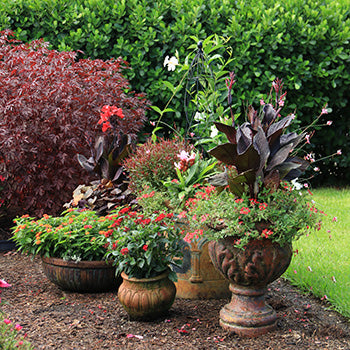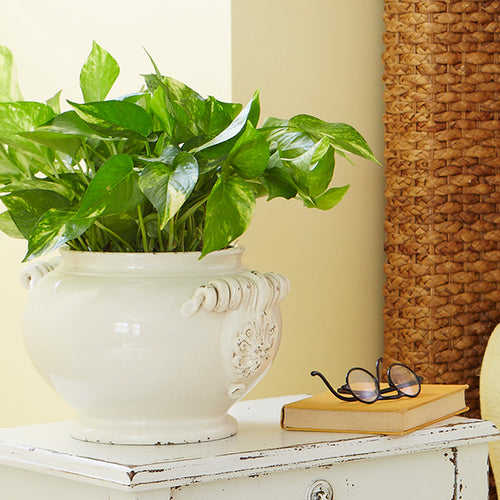By Doug Jimerson
Big, bold outdoor ferns add character and beauty to porches, decks, and terraces. These easy-care plants thrive in low-light conditions, making them an ideal choice for sheltered situations. Use outdoor ferns in hanging baskets, window boxes, urns, and planters. Here’s a quick guide to help you select some of the best outdoor ferns.

Boston Fern
Native to Florida, Mexico, and Central America, Boston fern was first “discovered” in a shipment of plants sent to Boston in the 1800s (and thus it earned its common name). Soon this elegant plant became popular because it could survive the cool, dark environment of Victorian living rooms. Its graceful, arching fronds and rich, green color also helped make Boston fern a best seller. Today, Boston fern is still a top pick for indoor and outdoor settings. But, because Boston fern can grow 3 feet tall and 3 feet wide, it are often a better choice for outdoor situations. In zones 9-11, Boston fern can be planted directly in the ground.

Macho Fern
Here’s a plant that lives up to its name. This tough-as-nails fern can grow 6 feet tall and wide, making it a much better choice for your porch or patio than your front parlor than traditional Boston fern. Macho ferns have long, arching branches with wide, dark green fronds. Plant macho fern in large hanging baskets, or oversized urns, pots, or tubs. Macho ferns are hardy planted in the ground from zones 9-11.
Because of their spectacular size, macho ferns usually look best by themselves. They can swallow up smaller plants in container gardens.
Note: You can bring this tropical fern indoors as a large houseplant if you'd like to save it for the winter.
Get tips for saving your favorite tropical plants before winter.

Kimberly Queen Fern
If you love ferns, but forget to water them, check out spectacular Kimberly Queen fern. These bold beauties are Australian natives that can take a bit more heat and drought (and sun) than other outdoor ferns. Kimberly Queen ferns have gorgeous upright habits that makes them outstanding choices for urns or vertical containers. The plants grow 3 feet tall and wide and develop handsome spots (spores) on the undersides of each leaf. Kimberly Queen fern can also be grown in the garden in zones 9-11.
Because Kimberly Queen fern has an upright habit, it's better suited to urns, container gardens and window boxes than hanging baskets; Boston fern is a more traditional pick for beautiful hanging baskets. Like Boston fern and macho fern, you can bring Kimberly Queen fern indoors as a houseplant to save it over winter.

Perennial Ferns
Besides tropical ornamental ferns such as Boston, macho, and Kimberly Queen, there’s a host of perennial ferns that you can plant in the flower border or landscape. Most of these plants are winter hardy and come back bigger and better every year. Hardy ferns include:
- Japanese holly fern
- Japanese Painted fern
- Cinnamon fern
- Dixie wood fern
- Fortune’s hardy holly fern
- Ghost fern
- Korean rock fern
- Lady fern
- Wood fern
Shopping for Ferns
When shopping for ferns to decorate your deck, patio, porch, or balcony -- or plant outside in your garden, look for full, balanced plants with lush, vibrant foliage. Many ferns (especially tender varieties such as Boston, macho, and Kimberly Queen) will have gray-green or olive-green foliage instead of their traditional rich green color. Most bounce back pretty quickly when watered after being too dry.
If you're looking at ferns for hanging baskets, check to see if plants are rootbound. The more roots there are in the pot, the faster the hanging basket will dry out. Sometimes ferns, especially toward the end of the season, can get rather rootbound. It can be common to see lopsided ferns sold in stores; the fronds break and bend when pressed up against each other -- but don't let that deter you; with proper care (see tips below), your ferns will rebound quickly.
When shopping for perennial ferns, keep in mind they go dormant during the winter. Perennial ferns sold in the early spring may not have much growth on them yet. Because they grow a bit slower than tropical ferns, buy the largest plants you can find if you want to make a statement in your garden the first year. Different fern varieties have varying growth rates. Japanese painted fern, for example, is a slow grower, but ostrich ferns can grow fast when it's happy.
Buy Outdoor Ferns
Find Costa Farms ferns at your favorite local garden center or online via one of our retailer partners.
Fern Care
All ferns, whether tropical or hardy, prefer a shaded or partially shaded location with rich, slightly moist soil that's rich in organic matter (such as compost). They also enjoy high humidity and love an occasional shower. Feed ferns with a slow-release granular fertilizer. Tropical ferns are sensitive to frost so move them to a sheltered location if cold weather threatens. To get your ferns off to the best possible start, topdress the soil with a couple of inches of compost after planting. Then mulch ferns to prevent weed competition and to help protect them from temperature extremes.
Ferns in containers need more frequent watering than their counterparts in the ground since containers (especially hanging baskets) dry out a bit faster. During especially hot, dry, windy weather, potted ferns may need watering once a day or so to keep them from drying out. Always check soil moisture before you water, though, to avoid overwatering your ferns.
Get tips for adding ferns for summer interest in your outdoor spaces!
Discover more ideas for decorating with fabulous ferns.
















